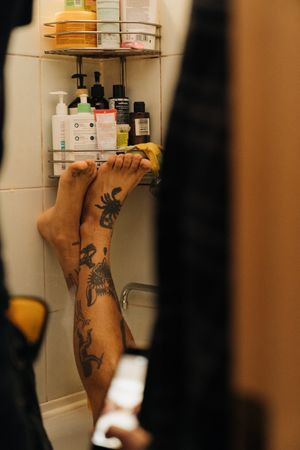So, you’ve just gotten a new piece of ink and naturally wonder, “Can I shower after getting a tattoo?” Absolutely, you can shower after getting a tattoo, but it’s crucial to do it right to protect your fresh body art. At tattooat.com, we’re dedicated to providing you with the best aftercare advice so that your tattoo heals beautifully and stays vibrant. Learn the best practices for maintaining your body art, including keeping it clean with antibacterial soap, understanding the healing process, and knowing how to protect it from infection.
1. Showering After a Tattoo: The Initial Hours and Days
The first few days are critical for your tattoo’s healing. Understanding when and how to shower can significantly impact the outcome.
How Soon After Getting a Tattoo Can You Shower?
You can shower, but carefully, 3-4 hours after getting inked if a Saniderm bandage protects your tattoo. However, it is wise to wait 24 hours to unwrap your tattoo and shower if you have a plastic wrap. In either case, shower in cold or lukewarm water, and avoid prolonged soaking or submerging your tattoo in water for 3-4 weeks. According to Inked Magazine, a leading authority in tattoo culture, waiting at least 24 hours allows the initial sealing process to begin, minimizing the risk of infection.
What Happens if You Shower Too Soon After Getting a Tattoo?
Showering too soon, especially with hot water, can open the pores around the tattoo, causing ink to leach out. According to research from Portland State University’s Art Department, showering soon after getting a tattoo may lead to infection and blurred lines. This is why it’s crucial to follow your tattoo artist’s specific aftercare instructions.
2. The Right Way to Shower with a New Tattoo
Knowing the right techniques for showering with a new tattoo ensures cleanliness without compromising the healing process.
How Should You Protect Your Tattoo During a Shower?
If your tattoo artist has applied a Saniderm bandage, it’s designed to be waterproof. However, avoid directing the full force of the shower stream directly onto the tattoo. According to tattoo artists, it’s still wise to keep your tattoo out of the heavy flow of the shower water for sensitivity’s sake. If you have a plastic wrap:
- Carefully remove the plastic wrap after 24 hours.
- Gently wash the tattooed area with lukewarm water and antibacterial soap.
- Pat it dry with a clean paper towel.
- Apply a thin layer of tattoo aftercare ointment.
What Kind of Soap Should You Use?
Use a mild, fragrance-free, antibacterial soap to clean the tattooed area. Avoid soaps with harsh chemicals or alcohol, as these can dry out the skin and interfere with the ink. Tattooat.com recommends gentle cleansers, such as those containing tea tree oil or mild citrus extracts, to keep bacteria at bay without causing irritation.
How Often Should You Shower?
Keep showers brief and avoid prolonged exposure to water. Showering once a day is generally sufficient to keep the tattoo clean without overhydrating it. According to experts at tattooat.com, limiting shower time to 10-15 minutes can significantly reduce the risk of complications.
 Woman carefully washing her new tattoo in the shower with antibacterial soap and lukewarm water, ensuring proper hygiene and protection
Woman carefully washing her new tattoo in the shower with antibacterial soap and lukewarm water, ensuring proper hygiene and protection
3. Understanding Saniderm and Tattoo Aftercare
Saniderm is a popular choice for tattoo aftercare, offering waterproof protection during the initial healing phase.
What is Saniderm, and How Does It Work?
Saniderm is a medical-grade, waterproof bandage designed to protect your new tattoo from bacteria and friction while allowing it to breathe. It’s designed for use by doctors in medical settings, such as hospitals. According to dermatologists, Saniderm can stay on for several days, reducing the need for frequent cleaning and moisturizing.
Showering with Saniderm: What You Need to Know
With Saniderm, you can shower straight after your tattoo has been completed, but you still need to be careful. Use lukewarm or cold water and keep the tattoo from heavy shower flow, instead opting to gently rinse the area of your tattoo. Make sure the bandage is secured to your skin before exposing it to water pressure from the shower.
When Should Saniderm Be Removed?
Follow your tattoo artist’s instructions on when to remove the Saniderm bandage. Typically, it’s safe to remove it after 3-4 days. Once removed, continue to care for your tattoo by washing it gently and applying a moisturizer. According to tattoo artists, improper removal of Saniderm can cause irritation, so be gentle and follow their guidelines.
4. Potential Risks and How to Avoid Them
While showering is necessary for hygiene, it also poses potential risks to a new tattoo. Understanding these risks and how to avoid them is critical for a smooth healing process.
What Are the Risks of Exposing a New Tattoo to Water?
Exposing a new tattoo to water can lead to several complications, including:
- Infection: Water can introduce bacteria into the open wound, leading to infection.
- Ink Leaching: Prolonged exposure to water can cause the ink to leach out, resulting in a faded or blurred tattoo.
- Delayed Healing: Overhydration can slow down the healing process and increase the risk of complications.
How Can You Minimize These Risks?
To minimize these risks:
- Keep showers short and avoid prolonged soaking.
- Use waterproof bandages like Saniderm to protect the tattoo.
- Avoid hot water, which can open the pores and cause ink to bleed.
- Gently pat the tattoo dry with a clean towel after showering.
5. The Healing Process: What to Expect Week by Week
The tattoo healing process typically takes 2-4 weeks, depending on the size and location of the tattoo. Knowing what to expect each week can help you adjust your aftercare routine accordingly.
Week 1: Initial Healing
During the first week, the tattoo will be tender, and some redness and swelling are normal. Keep the tattoo clean and moisturized, and avoid wearing tight clothing that can rub against it. According to tattoo artists, this is the most critical period for preventing infection.
Week 2: Itching and Peeling
In the second week, the tattoo will start to itch and peel. This is a normal part of the healing process. Avoid scratching the tattoo, as this can damage the ink and increase the risk of infection. Apply a moisturizer to relieve the itching.
Week 3-4: Continued Care
By weeks 3 and 4, the tattoo should be mostly healed. Continue to keep it clean and moisturized, and protect it from sun exposure. Once the tattoo is fully healed, you can resume your normal showering routine.
 A close-up of a tattoo in the second week of healing, showing the typical itching and peeling, with a hand gently applying moisturizer
A close-up of a tattoo in the second week of healing, showing the typical itching and peeling, with a hand gently applying moisturizer
6. Long-Term Tattoo Care: Keeping Your Ink Vibrant
Once your tattoo is fully healed, long-term care is essential to keep it looking its best.
Moisturizing and Hydration
Keep your skin hydrated by drinking plenty of water and applying a moisturizer daily. According to dermatologists, well-hydrated skin helps to keep the ink vibrant and prevent fading.
Sun Protection
Protect your tattoo from sun exposure by applying a high-SPF sunscreen whenever you’re outdoors. UV rays can cause the ink to fade and damage the skin. Experts at tattooat.com recommend using a broad-spectrum sunscreen with an SPF of 30 or higher.
Regular Check-Ups
Pay attention to any changes in your tattoo, such as fading, blurring, or skin irritation. If you notice anything unusual, consult with your tattoo artist or a dermatologist.
7. Activities to Avoid After Getting a Tattoo
Certain activities can interfere with the healing process and increase the risk of complications.
Swimming
Avoid swimming in pools, oceans, or hot tubs until your tattoo is fully healed. Chlorine, salt water, and bacteria can cause infection and damage the ink. A general rule of thumb is to give your new tattoo a minimum of three weeks away from any kind of pool, ocean, or bath. Washing your tattoo with warm or cold water and a mild, fragrance-free, antimicrobial soap is totally fine and is actually recommended for hygiene reasons.
Soaking in Baths
Avoid taking baths or soaking your tattoo in water for prolonged periods. Soaking can cause the ink to leach out and increase the risk of infection. Wait 3-4 weeks to swim after getting a tattoo.
Excessive Sweating
Avoid activities that cause excessive sweating, such as intense workouts or saunas. Sweat can irritate the tattoo and increase the risk of infection.
8. Addressing Common Concerns and Myths
Many myths and misconceptions surround tattoo aftercare. Here, we address some common concerns and provide accurate information.
Myth: You Can’t Get a Tattoo Wet
Fact: You can shower after getting a tattoo, but it’s essential to do it correctly. Avoid prolonged soaking and use a waterproof bandage to protect the tattoo.
Myth: All Soaps Are Safe for New Tattoos
Fact: Not all soaps are safe. Use a mild, fragrance-free, antibacterial soap to clean the tattoo. Avoid harsh chemicals or alcohol, as these can dry out the skin and interfere with the ink.
Myth: Scratching a Tattoo Is Okay If It Itches
Fact: Never scratch a tattoo, as this can damage the ink and increase the risk of infection. Apply a moisturizer to relieve the itching.
 A person using a tattoo aftercare balm, with aloe vera and tea tree oil, to soothe and moisturize their new tattoo
A person using a tattoo aftercare balm, with aloe vera and tea tree oil, to soothe and moisturize their new tattoo
9. Showers After Tattoos: Understanding Water Temperature
When it comes to showering after getting a tattoo, water temperature plays a significant role in the healing process.
Why Does Water Temperature Matter?
The temperature of the water can affect the pores of your skin and the stability of the ink. Hot water can open up the pores, causing the ink to leach out and potentially leading to fading or blurring of the tattoo. Additionally, hot water can increase blood flow to the area, which might cause more swelling and discomfort.
The Best Water Temperature for Showering After a Tattoo
Lukewarm or cold water is the best option for showering after getting a tattoo. Lukewarm water is gentle on the skin and helps to keep the pores closed, reducing the risk of ink loss. Cold water can further minimize swelling and soothe any discomfort.
How to Adjust Your Shower Routine
- Check the Water Temperature: Before stepping into the shower, ensure the water is lukewarm or cool. You can test the water with your hand or elbow to make sure it’s not too hot.
- Avoid Direct Contact: Keep the tattooed area out of the direct flow of the water. Use your hand to lightly rinse the tattoo, avoiding any strong pressure.
- Keep Showers Short: Limit your shower time to 10-15 minutes to prevent prolonged exposure to water.
10. Understanding the Impact of Different Shower Products
Aside from soap, other shower products like shampoos, conditioners, and body washes can also affect your new tattoo.
Shampoos and Conditioners
Ingredients in shampoos and conditioners can sometimes irritate new tattoos, especially if they contain sulfates, fragrances, or harsh chemicals. When showering, try to keep these products away from the tattooed area. After washing your hair, rinse thoroughly to ensure no residue remains on the tattoo.
Body Washes and Scrubs
Similar to soaps, body washes with strong fragrances or exfoliating beads can be harmful. Opt for gentle, fragrance-free body washes. Avoid using scrubs, loofahs, or washcloths on the tattoo during the initial healing phase, as these can cause irritation and introduce bacteria.
Alternative Cleansing Options
If you’re concerned about shower products affecting your tattoo, consider using a mild, diluted antibacterial soap specifically for the tattooed area. This can help you keep the tattoo clean without exposing it to potentially harmful ingredients.
11. Recognizing Signs of Infection
Despite your best efforts, infections can sometimes occur. Knowing how to recognize the signs of an infection is crucial for timely treatment.
Common Signs of Tattoo Infection
- Excessive Redness: Some redness is normal, but if the area around the tattoo becomes excessively red and inflamed, it could be a sign of infection.
- Swelling: A moderate amount of swelling is expected, but excessive swelling accompanied by pain is a warning sign.
- Pus or Drainage: Any discharge of pus or fluid from the tattoo is a clear indication of an infection.
- Fever or Chills: If you develop a fever or chills, it could mean the infection has spread beyond the tattoo.
- Foul Odor: An unpleasant smell coming from the tattoo area is another sign of infection.
What to Do If You Suspect an Infection
- Consult a Healthcare Professional: If you notice any signs of infection, seek medical attention immediately. A doctor can diagnose the infection and prescribe appropriate treatment, such as antibiotics.
- Follow Aftercare Instructions: Continue to follow your tattoo artist’s aftercare instructions diligently.
- Avoid Self-Treatment: Do not attempt to treat the infection yourself with over-the-counter remedies without consulting a healthcare professional.
12. Showers and Tattoos: Specific Considerations
Different factors, such as the size, location, and style of the tattoo, can influence how you should approach showering.
Large Tattoos
Large tattoos cover a larger area of the skin, making them more susceptible to complications. Be extra cautious when showering, and ensure the entire tattoo is protected.
Tattoos in Sensitive Areas
Tattoos in sensitive areas, such as the ribs, feet, or inner arms, may require more gentle care. Avoid harsh products and use lukewarm water.
Different Tattoo Styles
Different tattoo styles, such as traditional, watercolor, or blackwork, may have varying healing times and needs. Follow your tattoo artist’s specific recommendations based on the style of your tattoo.
13. Optimizing Your Shower Environment
Creating the right shower environment can help to protect your new tattoo and promote healing.
Keep Your Shower Clean
Ensure your shower is clean to minimize the risk of bacteria exposure. Regularly clean the showerhead, walls, and floor.
Use a New Towel
Always use a clean, fresh towel to pat your tattoo dry. Avoid using shared towels, as they can harbor bacteria.
Consider a Shower Filter
If you live in an area with hard water or high chlorine levels, consider installing a shower filter to remove impurities that can irritate the skin.
 A bathroom with a clean shower, featuring a filtered showerhead and fresh towels, creating an ideal environment for tattoo aftercare
A bathroom with a clean shower, featuring a filtered showerhead and fresh towels, creating an ideal environment for tattoo aftercare
14. Showers and Tattoos: Addressing Scabbing
Scabbing is a common part of the tattoo healing process. Proper care during showering can help manage scabbing and prevent complications.
Why Does Scabbing Occur?
Scabbing is the body’s natural response to a wound. When the skin is injured, blood and fluids can dry on the surface, forming a scab. While scabbing is a normal part of healing, excessive scabbing can prolong the process and increase the risk of scarring.
How to Manage Scabbing During Showers
- Gentle Cleansing: Use a mild, antibacterial soap to gently cleanse the tattooed area during showers. Avoid scrubbing or using abrasive products.
- Lukewarm Water: Shower with lukewarm water to prevent the scabs from becoming too soft and falling off prematurely.
- Pat Dry: After showering, gently pat the tattoo dry with a clean, soft towel. Avoid rubbing, which can dislodge the scabs.
- Moisturize: Apply a thin layer of tattoo aftercare ointment to keep the area moisturized and promote healing.
What to Avoid
- Picking Scabs: Never pick at scabs, as this can remove ink and increase the risk of infection and scarring.
- Prolonged Water Exposure: Avoid soaking the tattoo or spending too much time in the shower, as this can soften the scabs and cause them to fall off too soon.
15. Showers and Tattoos: Dealing with Itching
Itching is another common side effect of tattoo healing. While it can be tempting to scratch, it’s important to resist the urge.
Why Does Itching Occur?
Itching is a sign that the skin is healing. As the skin cells regenerate, they can trigger an itchy sensation. Additionally, the tattoo ink itself can sometimes cause irritation.
How to Relieve Itching During Showers
- Cool Water: A cool shower can help to relieve itching temporarily. Avoid hot water, which can worsen the itch.
- Gentle Cleansing: Use a mild, fragrance-free soap to gently cleanse the area. Avoid harsh soaps that can dry out the skin.
- Moisturizing: Apply a thin layer of tattoo aftercare ointment to keep the skin moisturized and reduce itching.
Alternative Remedies
- Cold Compress: Applying a cold compress to the tattoo can help to alleviate itching.
- Loose Clothing: Wear loose, breathable clothing to avoid irritating the tattoo.
FAQ: Showering After a Tattoo
1. Can I use regular soap on my new tattoo?
No, it’s best to use a mild, fragrance-free, antibacterial soap. Harsh chemicals and fragrances can irritate the tattoo.
2. What if my tattoo gets accidentally soaked in the shower?
Gently pat it dry with a clean towel and apply a thin layer of aftercare ointment. Monitor for any signs of infection.
3. Can I use a loofah to clean my tattoo?
No, avoid using loofahs or washcloths, as these can be abrasive and harbor bacteria.
4. How do I know if my tattoo is infected?
Signs of infection include excessive redness, swelling, pus or drainage, fever, and foul odor.
5. Can I exercise and shower afterward?
Avoid intense workouts during the initial healing phase. If you do exercise, gently clean the tattoo afterward and avoid prolonged exposure to sweat.
6. How long should I wait before taking a bath?
Wait 3-4 weeks before taking a bath or soaking your tattoo in water.
7. Is it okay to use a moisturizer with fragrance?
No, use a fragrance-free moisturizer to avoid irritation.
8. What if my Saniderm bandage comes loose in the shower?
If the Saniderm bandage comes loose, remove it carefully and follow your tattoo artist’s instructions for continued care.
9. Can I use a hair dryer to dry my tattoo after showering?
No, avoid using a hair dryer, as the heat can irritate the tattoo. Gently pat it dry with a clean towel.
10. What should I do if my tattoo starts to bleed after showering?
If your tattoo starts to bleed, apply gentle pressure with a clean cloth and consult with your tattoo artist or a healthcare professional.
At tattooat.com, we’re dedicated to providing you with the most reliable information and resources for tattoo aftercare. Remember, proper aftercare is essential for ensuring your tattoo heals beautifully and remains vibrant for years to come. Explore tattooat.com for design inspiration, trusted artists, and comprehensive guides to enhance your tattoo journey.
Address: 1825 SW Broadway, Portland, OR 97201, United States. Phone: +1 (503) 725-3000. Visit tattooat.com today.